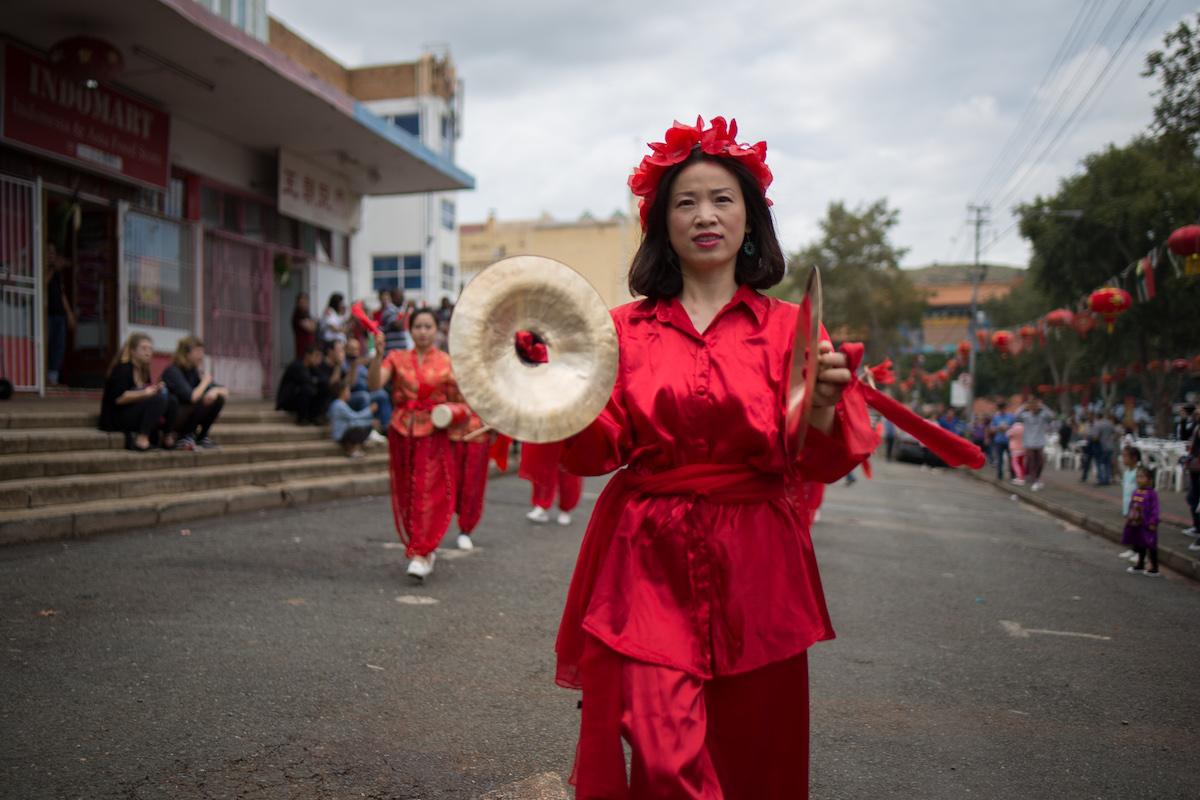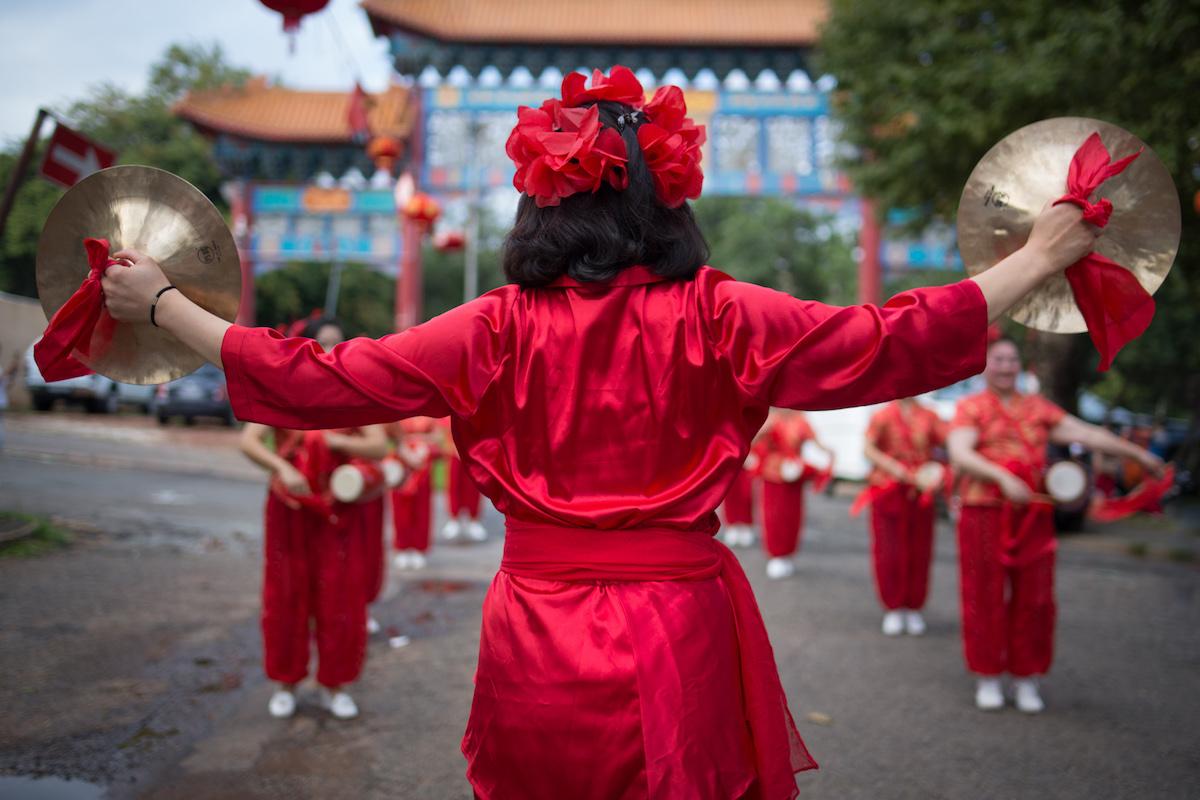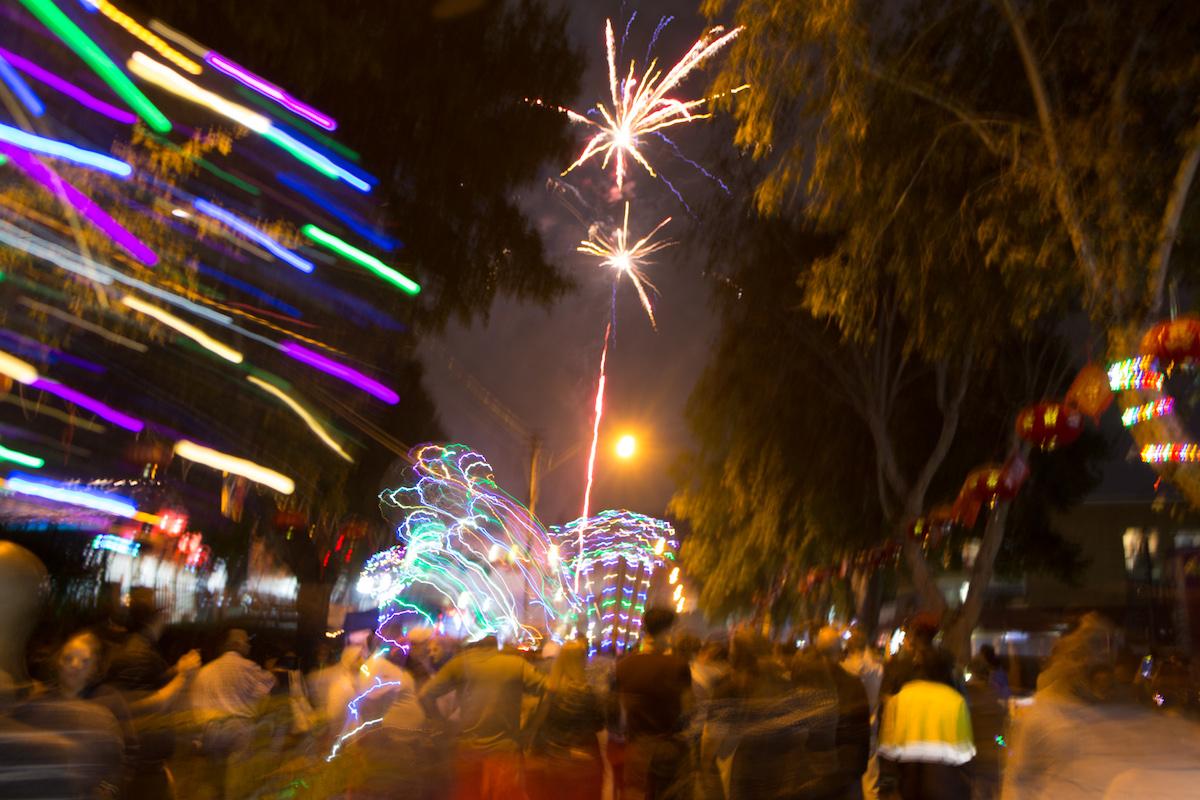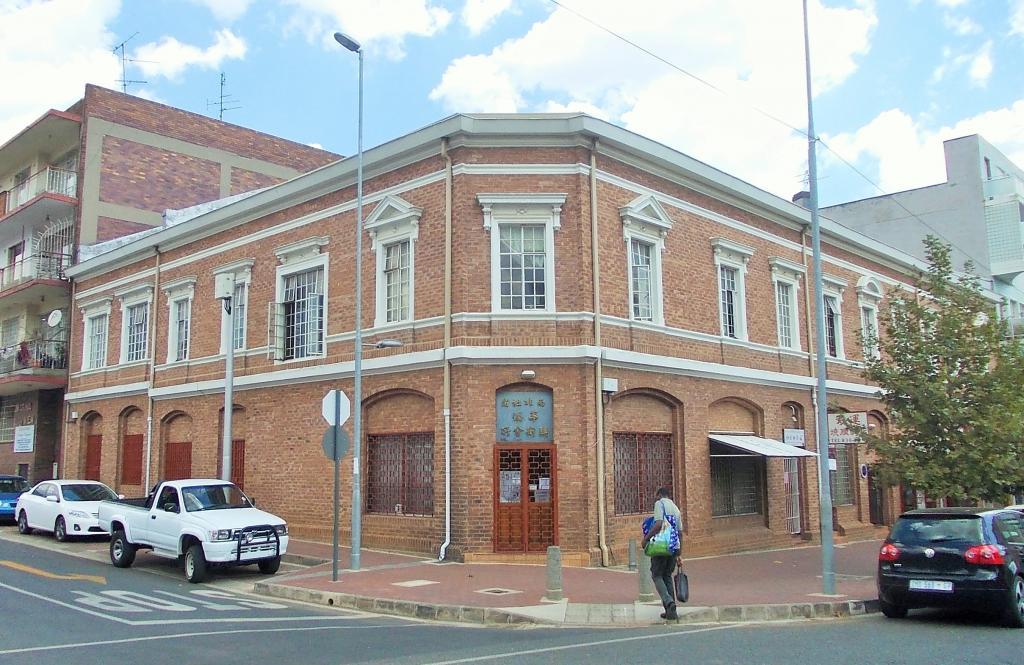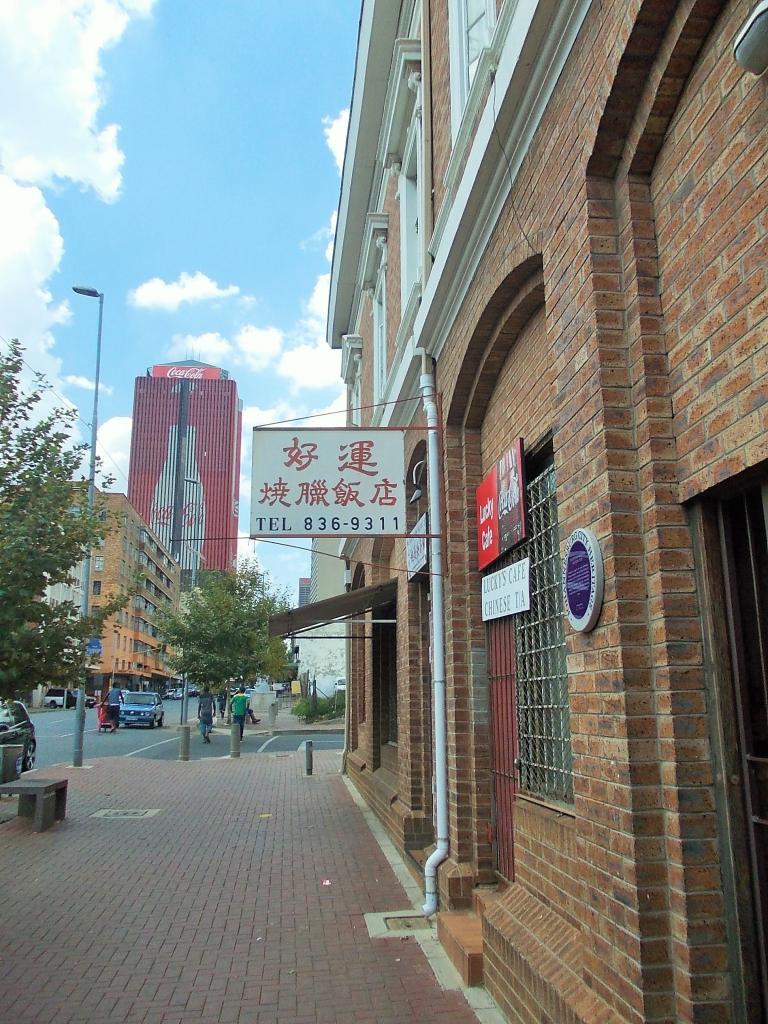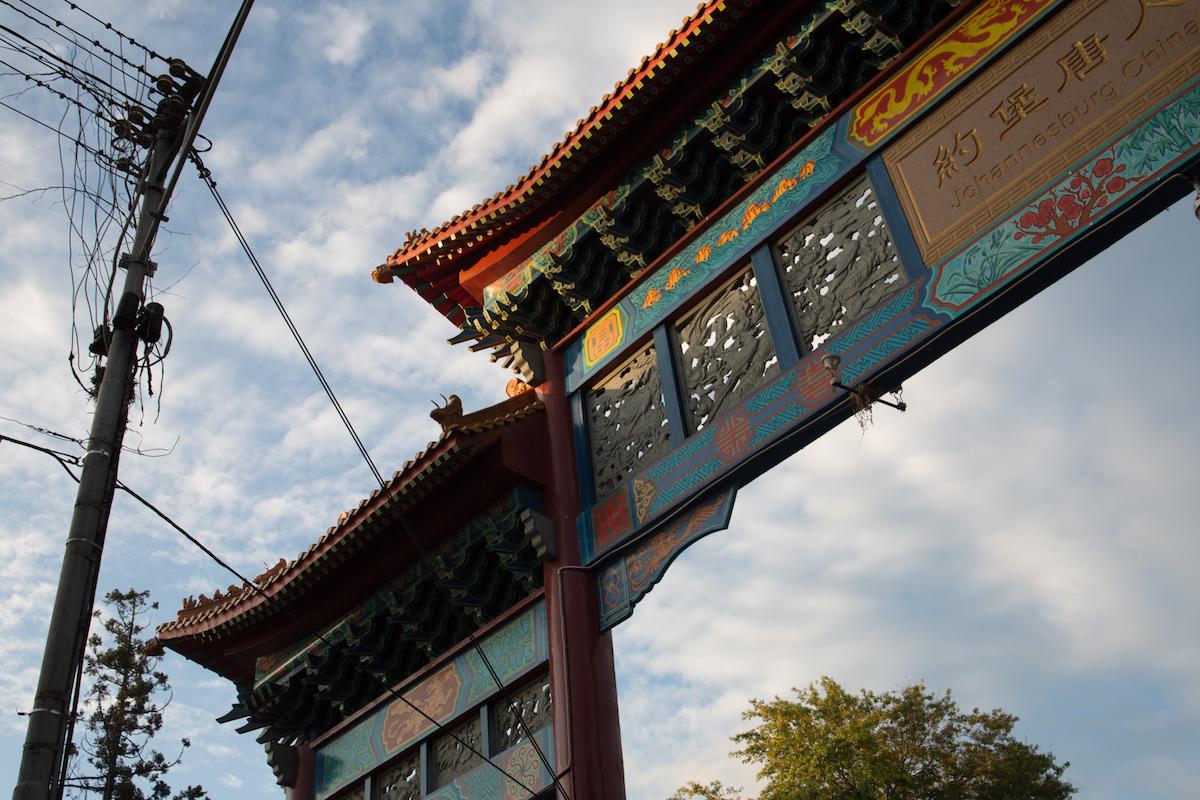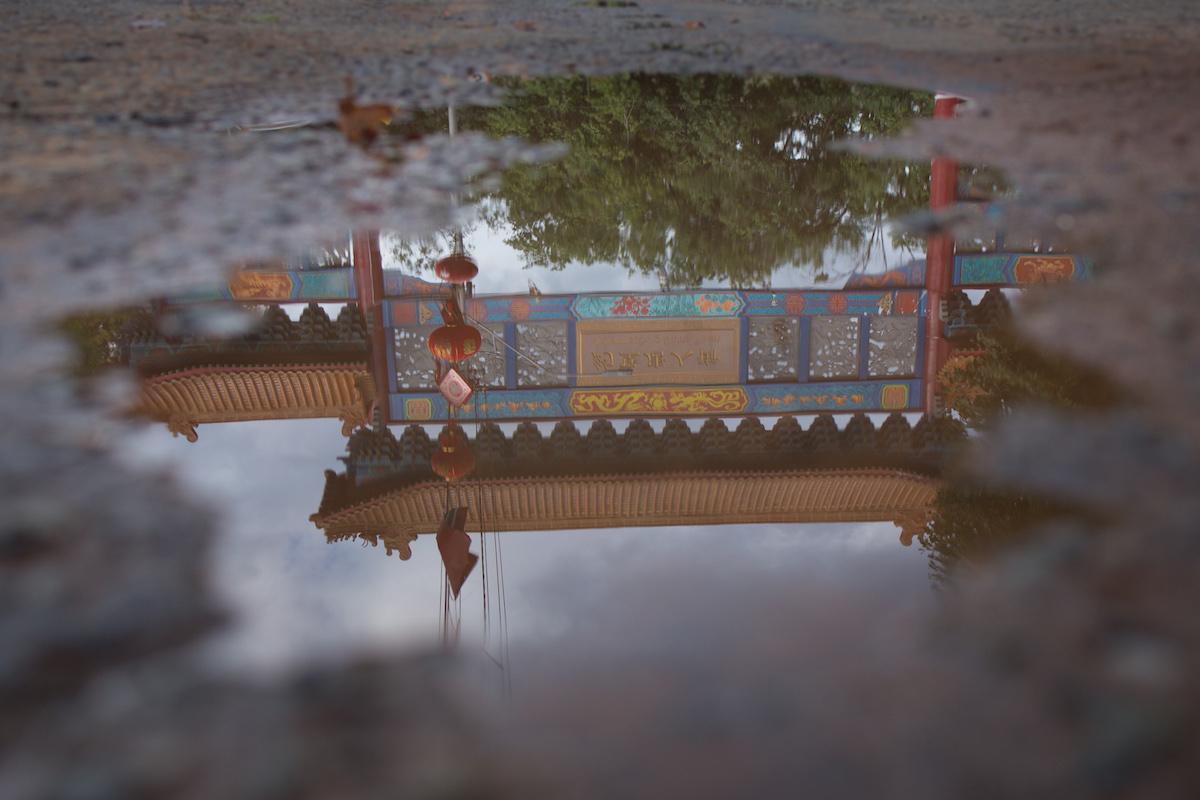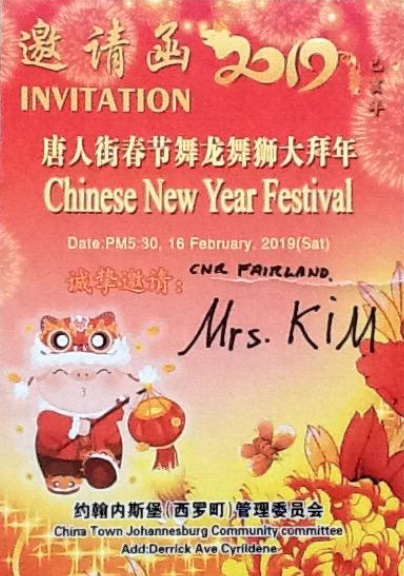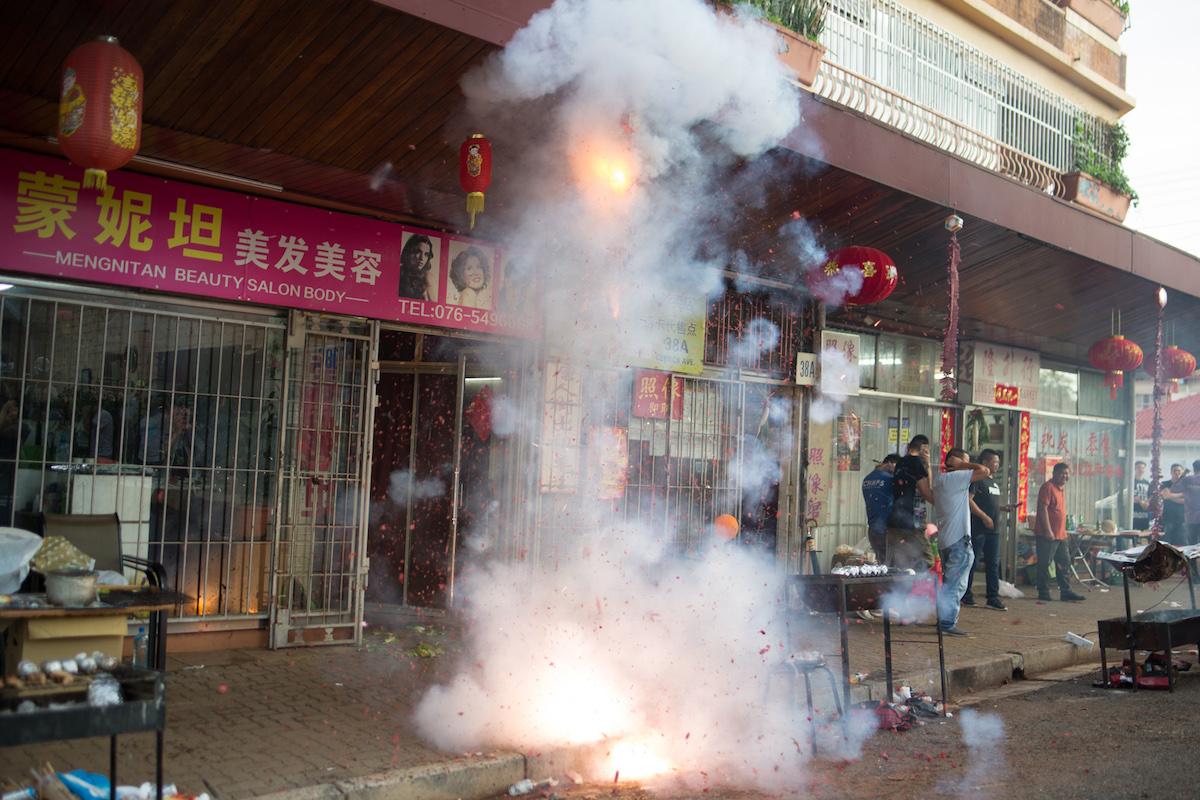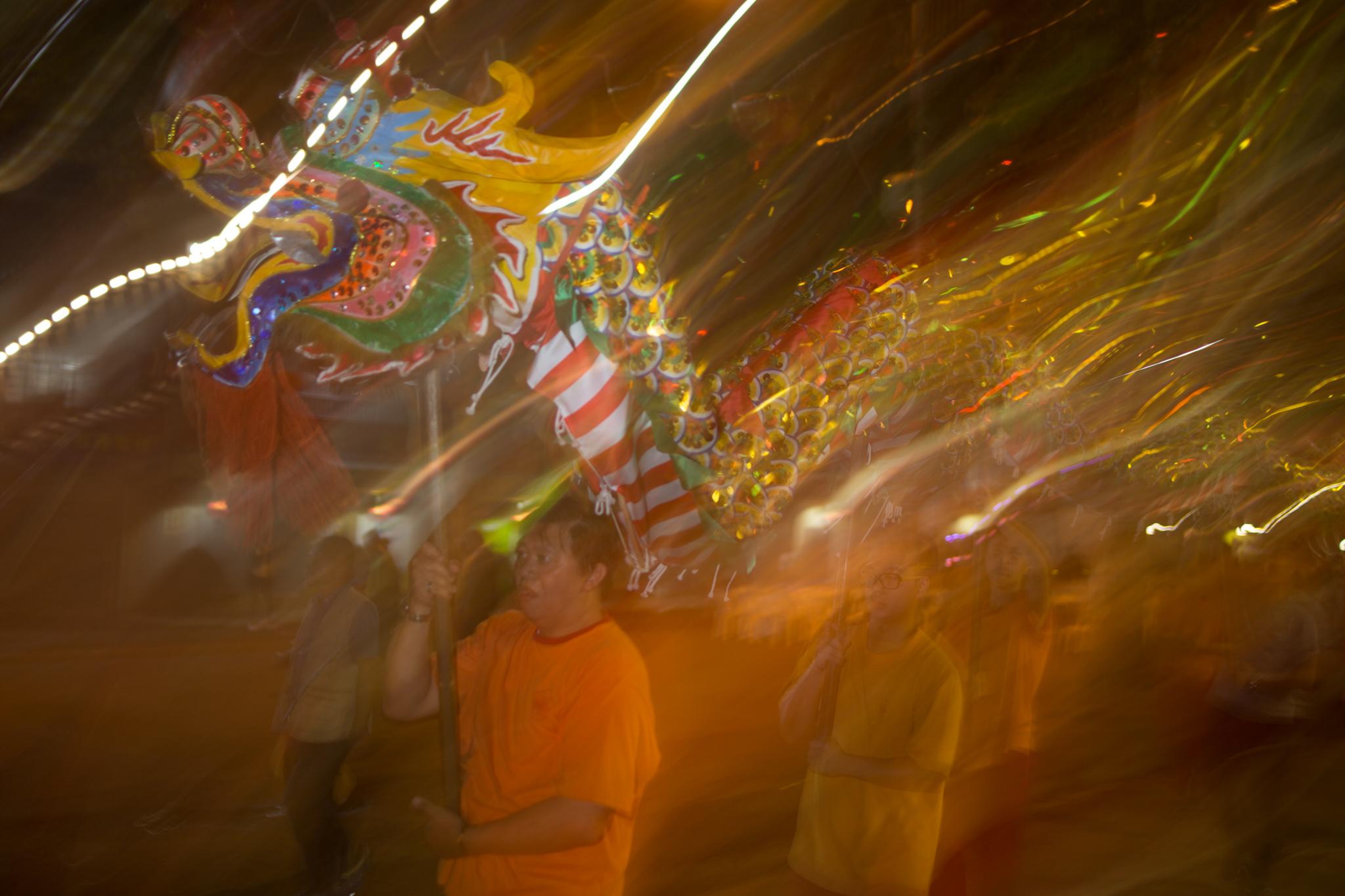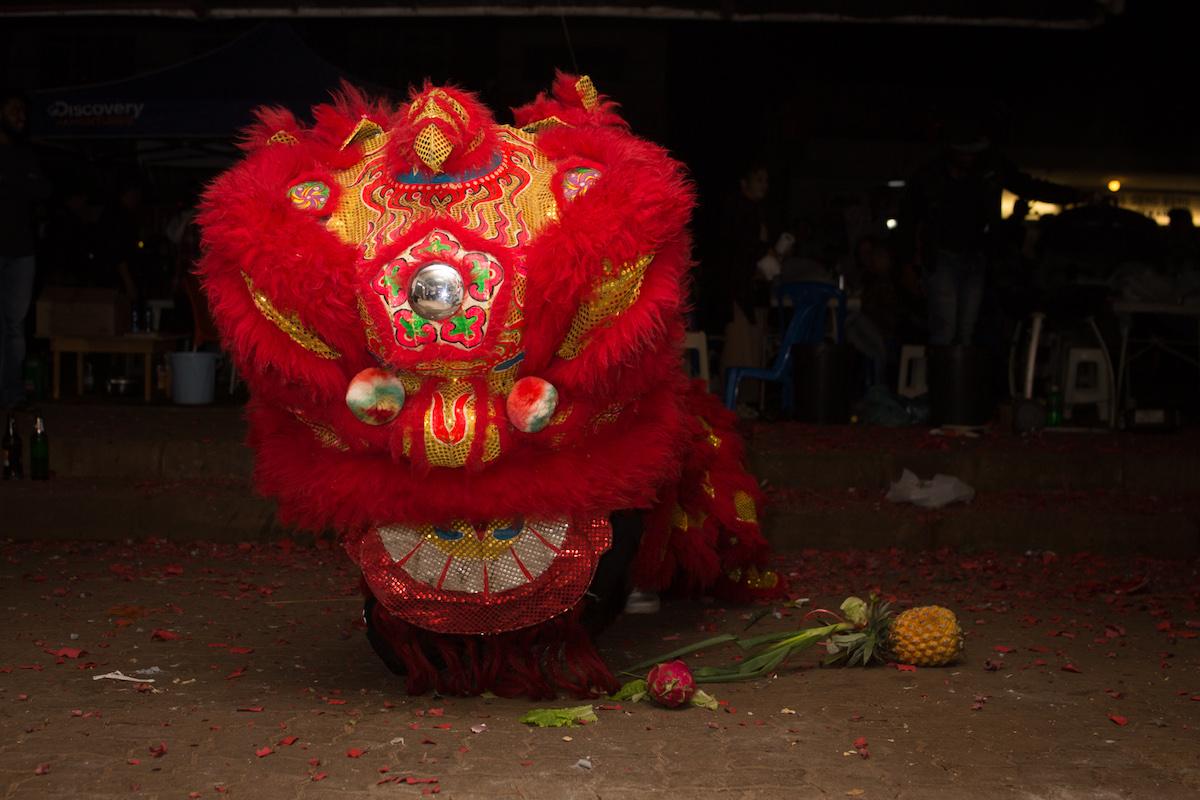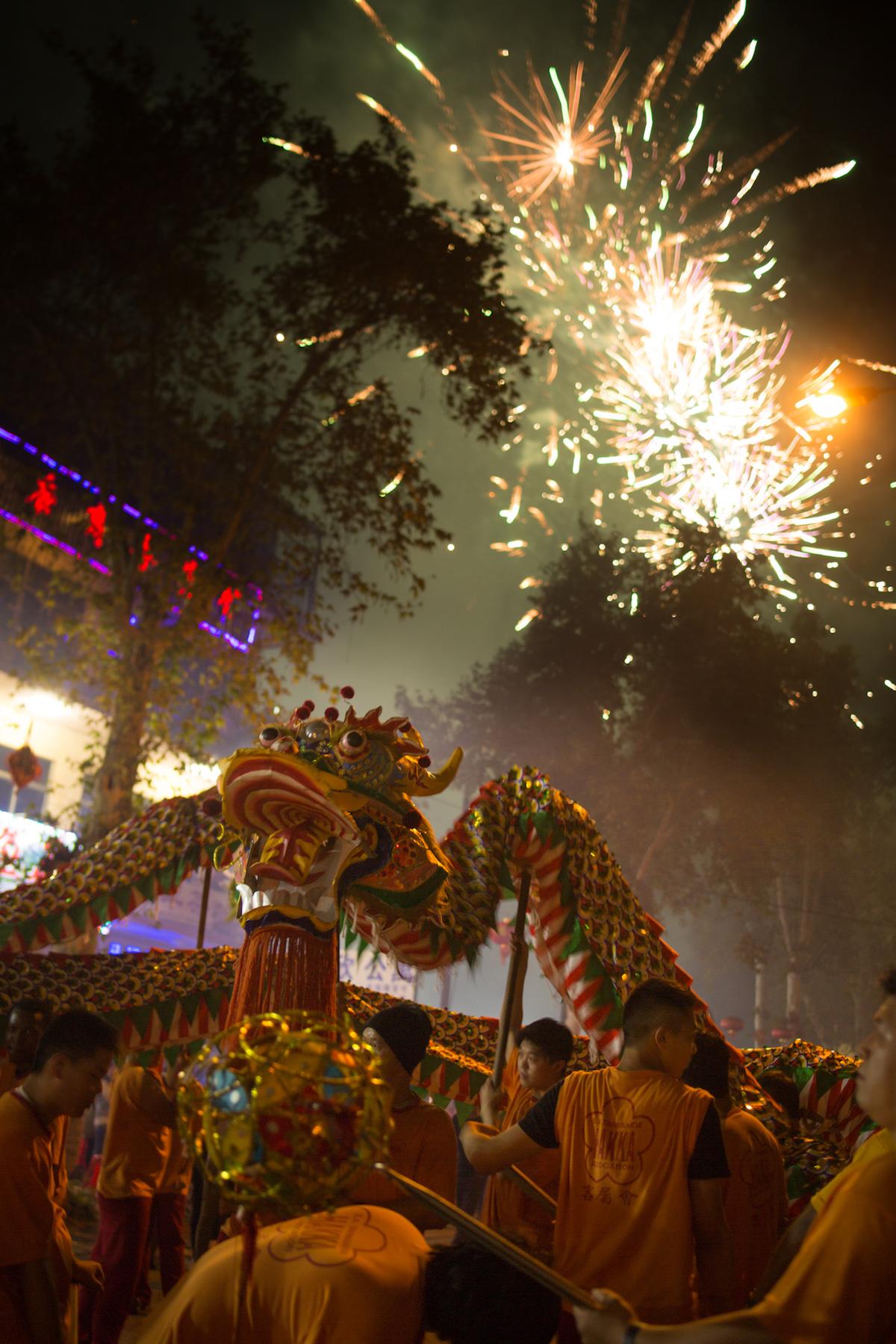
Disclaimer: Any views expressed by individuals and organisations are their own and do not in any way represent the views of The Heritage Portal. If you find any mistakes or historical inaccuracies, please contact the editor.
On Saturday 16th February, Chinatown in Cyrildene put on its festive finery and glamour costumes. The colour red predominated and red symbolises happiness. The Chinatown in Cyrildene was celebrating the Chinese New Year in style with the biggest and best of street parties.
As the sun began to drop over Cyrildene, the ladies in red marched with cymbals and drums. (Mark Straw)
The celebration is a harbinger of good luck and a happy year ahead for the residents, shopkeepers, neighbours, spectators and friends. It was a special event that highlights that Chinese culture is a vibrant part of Johannesburg and that Chinese customs, myths, beliefs and celebrations are now a part of the city’s heritage. Culture and heritage are for sharing. In China the new year festivities, which extend over a month from January to February, are also called the Spring Festival.
A vibrant part of Johannesburg (Mark Straw)
I have known Cyrildene for decades from when it was a stable, middle class, predominantly white suburb to the east of the city. As Johannesburg municipal boundaries were extended onto what were still farms, land was surveyed and townships established. The first residents built modest, mainly single storey dwellings on stands of about half an acre. The suburb dates from the 1930s and 1940s. Many early residents were second generation Jewish families who came here from the more densely populated Yeoville and Bellevue. Cyrildene was a step up in the world. The Cyrildene-Observatory Extension Hebrew Congregation was established in a private home in 1942, by 1950 a hall had been built and in 1964 a synagogue was erected. There is no church in the suburb.
In the seventies, it was the suburb my husband and I chose when we were young and newly married. We thought of trendy Melville or Westdene for our first home but it was my father who suggested we look at Cyrildene. He pointed out the quality of the interwar and post-war construction - a lemon face brick facade, established gardens, the ochre tiled roofs and the neatly shaped rounded bay windows were all signs of quality but modest building. We bought our first house at 56 Cooper Street and it was our home for six years. We paid exactly R19 000 for the house and could just manage the bond if we took in a tenant. We liked Cyrildene as it had all the amenities - a hairdresser, the Greek café, a pharmacy, a supermarket, a grocer, a liquor store and a library (on Derrick Avenue), a good primary school (on Glanville Avenue), and Athlone Girls High at the top of the hill. It was apartheid Johannesburg then and there was a segregated post office on Hettie Street with “European” and “non European” counters and entrances. We did not approve but that was the Johannesburg where we settled into life as young lecturers at Wits. Of course all that is now gone thankfully and there is no post office in Cyrildene!
The suburb of Cyrildene is situated on part of an old Witwatersrand farm called Doornfontein (portion named Doornfontein 24). In 1936 members of the Bezuidenhout family applied to the city to establish a township which they proposed calling Northcrest. According to Anna Smith's Johannesburg Street Names, the city rejected this name because it was a misnomer and sounded too much like Northcliff. But by 1937 the land had changed hands and Finborough Estates became the new owners. The township was called Cyrildene after Cyril Cooper; the key player in the new development. The suburb was proclaimed on 18 May 1938.
Cyrildene was and still is a suburb with a “good feel“ with the Linksfield ridge rising above on the hillside. We could walk along Cooper Street to the end of the road where farmland started in what is today Morning Hill and Bruma. The main road in the suburb, lined with leafy pin oak trees, runs from the intersection with Broadway through Bruma where it is Queen Street. From Marcia Street heading north the name is Friedland Avenue and then half way up the hill it changes to Cooper Street. Cooper Street continues until Athlone Girls High where it becomes Frederick Street. It was a beautifully laid out suburb with winding roads and curious turns and link points. It was a consciously green suburb from the start with the nearby Harvey Nature Reserve, Oldroyd Park at the top of the hill, a small park on Cyril Crescent and Dixon Park off Aida Avenue. We loved walking in our suburb. In the late seventies change came with the opening up of the suburb of Morning Hill. Many dead end streets were cut through to the new suburb. New building stands were auctioned off and the sheep disappeared.
Between trees, neat houses, a mountain and a lake below, Cyrildene has “feng shui”. Change began almost imperceptibly in the 1980s and then speeded up in the 1990s as new immigrants saw an opportunity to work hard in a new rainbow country and improve their lifestyles. So a new Chinese immigrant community established themselves in the suburb. Mandarin and Cantonese began to be spoken and a street of restaurants emerged.
Cyrildene is quite unlike the old Johannesburg Chinatown to the west of the old CBD, in Commissioner Street near John Vorster Square where third and fourth generation South African Chinese made an original niche. This second Chinatown, has been created by the new Chinese immigrants to South Africa who arrived as the country opened up. Derrick Avenue was speedily transformed into a busy Chinese street with houses demolished and new double and triple storey apartment blocks and shops inserted on the large stands. New buildings were built in Chinese architectural style - they looked as though they had come straight out of Beijing. By- laws and building regulations seemed to be unimportant as trading stalls were inserted in gardens of the houses along Derrick Avenue, houses became resturants and shops, gardens were built over with rather make shift structures. Chinese calligraphy went up on shops. This was the place to find a good Chinese restaurant - a great meal served on rickety glass or plastic tables protected by plastic table cloths with paper napkins and wooden chopsticks. It was not fine dining but it was excellent food.
Transvaal Chinese United Club in old Chinatown (The Heritage Portal)
Looking past the Transvaal Chinese United Club up Commissioner Street (The Heritage Portal)
Cyrildene now began to appear in Chinese script (simplified Chinese: 西里尔德纳; traditional Chinese: 西里爾德納). Older residents sold up, died, emigrated and moved on and the new buyers of the suburb were Chinese families. At Bruma, the old Game store became an Oriental City and when the somewhat seedy and sleazy flea market there moved across the road into Ernest Oppenheimer Avenue, that too was displaced after a few years by a brand new Asian emporium of small shops that combined local South African craft souvenirs with mass produced Chinese industrial, household wares and toys of all types. The 'African' sense of place was retained with the pavement souvenir craft market along Ernest Oppenheimer Avenue with immigrants from the Congo, Kenya, Zimbabwe, Zambia and Malawi selling their hand made African bowls, soapstone sculptures, and beadwork.
Even though we had moved to Observatory, I still returned to Cyrildene to shop but now my shopping was exotic Chinese vegetables. I bought an electric wok and discovered the best place to buy fresh green Chinese vegetables, mushrooms, Chinese cabbage, endives, bok choy and giant onions was on the pavement stalls spilling out onto the street along Derrick Avenue. Half the time I did not know the names of the greenery I bought and my purchases happened with a great deal of pointing, smiles and always an extra something popped into my shopping - I began to appreciate the new Chinese culture and presence.
Remarkably the old street names of Cyrildene like Hettie, Beryl, Marcia, Finger, Friedland, Daphne, Cooper, Gladys, Glanville, Lorna and Friedland remained. They are all the names of the family and friends of Cyril Cooper and his company associates.
Chinatown was definitely here to stay when an extraordinary Chinese style arched gate decorated with lions and dragons was erected at the corner of Friedland and Derrick Avenue. You could be in Hue in Vietnam or in Hong Kong or in Los Angeles or perhaps a corner of old Peking (Beijing). And the man who was the honoured guest to open the gate to Chinatown was none other than President Jacob Zuma. That was in 2013. I wondered why he was able to take time out from his busy schedule in the Union buildings to come to humble Cyrildene for the unveiling. On the opening day traffic and security meant that the access to the airport was impossible. At the time of the 2014 general election, election posters appeared in Cyrildene, the script was Chinese and the Chinese community was urged to vote for the ANC. Our friends organized an election fancy dress party on election day and my costume was the Chinese voter and my slogan, “howzit my China”!
One of the gates to Chinatown (Mark Straw)
A creative piece of photography (Mark Straw)
It was the Chinese community that sponsored the construction of the arch, renting land from the City of Johannesburg. At the opening ceremony, welcoming President Zuma, the community spokesman, Mr Xinzhu, spoke of the desire of the Chinese community to include the arch in city tourism. Unfortunately the twin arch on the other end of Derrick Avenue (corner Marcia Street) remained a neglected skeletal structure for several years. It has now been completed and matches the Friedland Avenue Arch. There is no mistaking one is in Johannesburg’s newest, thriving Chinatown. In many ways Derrick Avenue is now the China tourist spot that brings China as we westerners would like it to be, right here to Johannesburg. I should add there are also some Thai restaurants in the area. We watched the large 1950s Cyrildene home at the corner of Hettie Street transformed into the Anong Thai restaurant and Thai massage centre.
At this years Chinese New Year celebrations we were fortunate to be the guests of Mr Danny Zhang, a senior figure in the Chinatown Johannesburg Community Committee and the owner of Kung Fu Kitchen (which has now grown into a chain). Derrick Avenue was turned into an outdoor boulevard for dining and was the setting for the street party of the year. Friedland Avenue, named for Philip Friedland, had now become Fairland Avenue on our invitation. We were the honoured guests at one of the possibly 25 tables set out on the street with grandstand views of the car park area. Our party was the only non-Chinese group.
Our invitation to the Chinese New Year Festivities. We were 'Mrs Kim's family' (my daughter Kim and her family, live opposite Mr Zhang).
Why were we the guests? Well Mr Zhang has become our neighbour in Observatory and during the last couple years we have built a great neighbourly relationship with him. The warm and generous Mr Zhang is keen to blend Chinese and South African local cultures. He is an impressive new immigrant to South Africa - hard working, energetic and community minded.
The Festival drew crowds of bystanders, spectators and onlookers. People filled the pavements for over 400m. It was a beautiful warm Jozi afternoon and festivities kicked off around 17h30. We had ringside seats to a grand celebration as the sun went down and the party got going. After sunset the fireworks lit up the sky. Fortunately the rain held off and it was not too cold. We were served a banquet. Plates of exotic dishes kept coming. Unusual platters of Chinese food were served, one after another, no two the same. It was a delicious variety of food and the taste sensation was to be savoured. Best was the salmon and a huge plate of pink prawns, but there was also calamari and sushi, sweet and sour pork, delicious duck, thin slices of beef, chicken that did not look like chicken and fish that tasted more like meat. Each dish, with so many different spices, tasted nothing like western Chinese cooking nor indeed like anything we opt for when visiting a Chinese restaurant. My husband said that the banquet was a bit like the grand business meals he is treated to when he visits Shanghai and is overfed to the point of longing for vegetarian status. The meat, fish and chicken dishes were interspersed with unusual vegetables dishes. The dessert was a huge platter of refreshing chunks of watermelon.
Firecracker - to chase away the evil and bring good luck for the coming year. (Mark Straw)
Apparently each Chinese restaurant was asked to supply one plate of food for each of the tables. Here was a division of labour, and specialities of the house were to the fore. All free and no charge to honoured guests. There was more food than one could manage in a week. I felt guilty at the quantity and there we were like lords with all the bystanders, visitors and security guys gawping as they stood watching us eat from their firework viewpoints on the pavements. In the end we offered food to the spectators and made new friends. Everyone was there to enjoy the fun and watch the parades, the festivity and the fireworks. It was a grand spectacle.
Colour, life, light and Chinese heritage in Johannesburg. (Mark Straw)
There were minimal formalities and Mr Zhang came to welcome us. The Chinese men who are the community leaders were all attired in western formal suits and ties. A bit like the communist party leaders look on TV in China and indeed a couple wearing official Chinese Communist emblems on their lapels (they could have been the reps of the diplomatic Corp). There were no long speeches.
A clear problem with Chinatown in Cyrildene is that it still looks like a chaotic construction site. Mayor Mashaba and the city need to arrive to fix potholes, lay new pavements, clear the weeds and create proper walkways. We need a city that cares for Chinatown and understands its cultural importance to Johannesburg. It was an odd mix of decaying infrastructure and a new Chinese burst of energy. The beautiful display made a grand statement but we need the city to invest in the new Chinatown - the roads, pavements, gutters, drains - those items of city infrastructure need to be perfect if this is to be a tourist mecca. My husband commented too that perhaps the city needs to invest in some Chinese lanterns.
The well known and popular restaurants on Derrick Avenue are Fisherman’s Plate, Fong Mei, Mongkok Chinese Restaurant, Kung Fu Kitchen (Mr Zhang’s restaurant, located in the old Cyrildene library) and Lian Fu - there is usually a regional specialization, but each restaurant offers value for money and a great evening’s dining on any night of the week. The Chinese New Year brings all the restaurants together in a cooperative effort to welcome their guests.
The festivities began with parades, dance and marching bands and of course the dragon dance. This is the year of the pig and the pig in Chinese mythology and belief is a symbol of wealth and prosperity. The size and warmth of the party on Derrick Avenue ushered in the year of the pig, 2019. It is going to be an excellent year.
The Dragon Dance (Mark Straw)
The Head of a Dragon (Mark Straw)
The Dragon Dance along Derrick Avenue was a highlight. The dragon is a theatre spectacle costume made to look like a decorated long dragon. The garish yellow and red sparkling dragon was supported by about 20 men as it made its way up the street. At each shop entrance noisy firecrackers were set off to chase out the evil spirits and the bad experiences of the previous year. It was all very noisy and conversation was no longer possible. If noise and the smell of gunpowder measured good luck and fortune for the year then this ceremonial bit brought on all that could be desired. Many Chinese people were dressed in traditional costumes and waving LED light sticks. It was a spectacle of glitz, glitter, glamour and a lot of fun.
One person came up to us and asked how did one book a table and a member of our party's reply was: “Well start by buying a house in Observatory next to Mr Zhang!“. I believe though that the restaurants did take bookings and offered fine fare. The crowds were so dense that we did not venture along the street but my friend Mark Straw was there with his camera and his photographs combine with my text. Thank you Mark!
A float (a decorated truck) of people came past throwing out fortune cookies and small good luck tokens and charms and sweets to the crowd. Everyone joined in the sense of occasion. I am sure there were some pick pockets and criminals among the now ballooning crowd but there was a security presence and we felt completely safe.
Then the fireworks display started. There was one cascade of rainbow rockets after another ending in multi coloured bright flashing stars descending and spreading over the night sky. I always feel transported back to childhood and Guy Fawkes day when we indeed bought firecrackers and fireworks from the nearest Chinese shop in Chinatown. There is something wasteful, cheerful, wicked and wonderful about fireworks. It is all about the thrill of the moment. Fireworks make me feel connected to the heavens but I also feel a little guilt to see all the creative destruction. The firework display continued for over two hours. The cost of the display must have been enormous.
Fireworks exploding above the Dragon (Mark Straw)
It was incredible for us to see how the old Cyrildene shops are now entirely Chinatown and out in street party mode. One Facebook Obs community member posted a sour comment about noise and war zones! But the lesson really is to embrace and enjoy the thrill of another culture. Wear red and share the happiness. Join a dragon dance - the longer the dragon the more good luck we shall all enjoy.
Thank you to Danny Zhang and the Chinese Community for your warm hospitality, a brilliant festival and bringing a new dimension to Johannesburg. Cyrildene has been truly been transformed into Chinatown.
Kathy Munro is an Honorary Associate Professor in the School of Architecture and Planning at the University of the Witwatersrand. She enjoyed a long career as an academic and in management at Wits University. She trained as an economic historian. She is an enthusiastic book person and has built her own somewhat eclectic book collection over 40 years. Her interests cover Africana, Johannesburg history, history, art history, travel, business and banking histories. She researches and writes on historical architecture and heritage matters. She is a member of the Board of the Johannesburg Heritage Foundation and is a docent at the Wits Arts Museum. She is currently working on a couple of projects on Johannesburg architects and is researching South African architects, war cemeteries and memorials. Kathy is a member of the online book community the Library thing and recommends this cataloging website and worldwide network as a book lover's haven.
Comments will load below. If for any reason none appear click here for some troubleshooting tips. If you would like to post a comment and need instructions click here.

